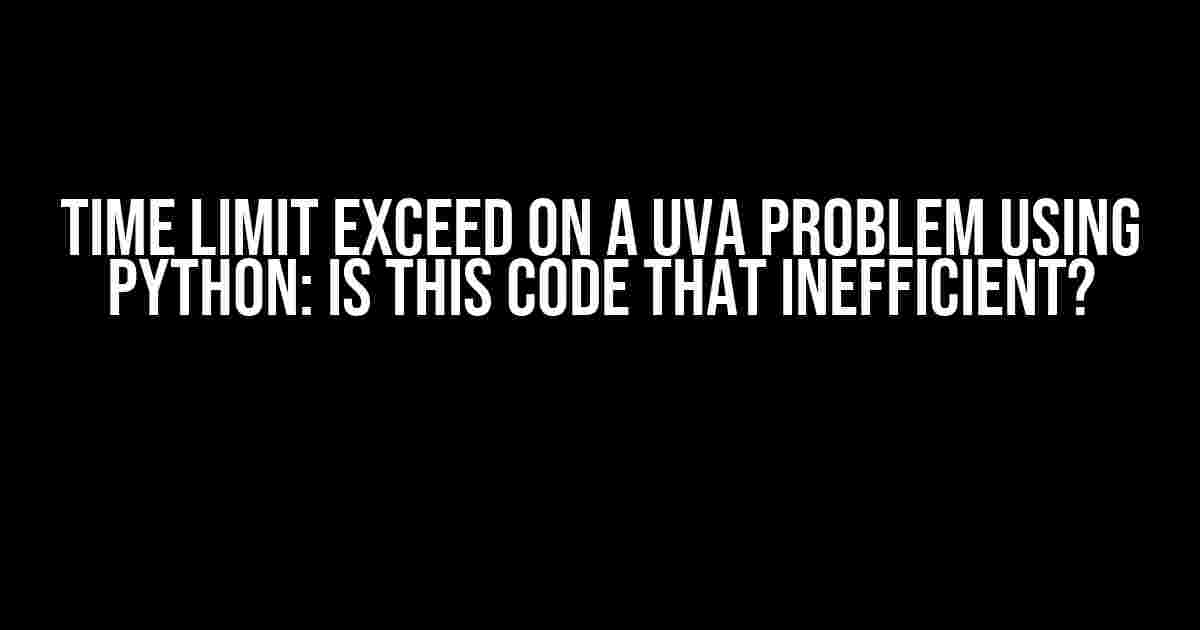Are you tired of seeing the dreaded “Time Limit Exceed” message on your Python solutions for UVA problems? Do you wonder what’s going wrong with your code? Fear not, dear programmer, for we’re about to dive into the world of optimization and explore the reasons behind this frustrating error.
Understanding Time Limit Exceed
Before we dive into the code, let’s understand what Time Limit Exceed (TLE) means. In the context of UVa Online Judge, TLE occurs when your program exceeds the maximum allowed time to execute, usually 1-2 seconds. This means your code is taking too long to process the input and produce the output.
Why Does TLE Happen?
There are several reasons why your Python code might be exceeding the time limit. Here are some common culprits:
- Inefficient algorithms**: Using a brute-force approach or an algorithm with high time complexity can lead to TLE.
- Unnecessary operations**: Performing redundant calculations or iterating over large datasets unnecessarily can slow down your code.
- Input size**: Large input sizes can cause your code to take longer to process, leading to TLE.
Analyzing the Code
Let’s take a look at an example code that might be causing TLE on a UVA problem. Suppose we’re trying to solve the “Fibonacci Number” problem, where we need to find the nth Fibonacci number.
def fibonacci(n):
if n <= 1:
return n
else:
return fibonacci(n-1) + fibonacci(n-2)
n = int(input())
print(fibonacci(n))
This code seems simple and straightforward, but it has a major flaw: it's recursively calculating the Fibonacci sequence, which leads to an exponential time complexity (O(2^n)). This means the code will take an exponentially long time to execute as the input size (n) increases.
Optimizing the Code
So, how can we optimize this code to avoid TLE? Here are some suggestions:
- Memoization**: Store the results of expensive function calls and reuse them when the same inputs occur. This technique can significantly reduce the time complexity.
- Dynamic Programming**: Break down the problem into smaller sub-problems and solve each only once, storing the results in a table or array.
- Iterative approach**: Replace recursion with an iterative approach, which can be faster and more efficient.
Let's apply these optimizations to our Fibonacci example:
def fibonacci(n):
fib = [0]*(n+1)
fib[1] = 1
for i in range(2, n+1):
fib[i] = fib[i-1] + fib[i-2]
return fib[n]
n = int(input())
print(fibonacci(n))
This optimized code uses dynamic programming to store the Fibonacci numbers in an array, reducing the time complexity to O(n). Now, the code should run much faster and avoid TLE.
Additional Tips for Optimization
Beyond optimizing algorithms, here are some additional tips to help you avoid TLE:
- Use efficient data structures**: Choose data structures that provide fast access and manipulation, such as lists or dictionaries.
- Avoid unnecessary input operations**: Minimize input operations by storing input data in a single pass or using buffering.
- Use caching**: Cache frequently accessed data or results to avoid redundant calculations.
- Profile your code**: Use profiling tools to identify performance bottlenecks and optimize those areas specifically.
UVA-Specific Tips
When solving UVA problems, keep the following tips in mind:
- Read the problem statement carefully**: Understand the constraints and expectations to avoid unnecessary computations.
- Choose the right language**: Python might not be the best choice for every problem. Consider using a faster language like C++ or Java when necessary.
- Test your code**: Ensure your code works correctly and efficiently by testing it with large input sizes.
Conclusion
Time Limit Exceed is a frustrating but common issue when solving UVA problems using Python. By understanding the reasons behind TLE, optimizing your algorithms, and applying additional tips, you can overcome this hurdle and submit successful solutions.
Remember, efficient coding is an art that requires practice, patience, and persistence. Don't be discouraged by TLE; instead, use it as an opportunity to improve your coding skills and optimize your solutions.
| Original Code | Optimized Code |
|---|---|
| Recursive Fibonacci (O(2^n)) | Dynamic Programming (O(n)) |
| Time Limit Exceed (TLE) | Acceptable Solution |
Happy coding, and don't let TLE get in your way!
Frequently Asked Question
Struggling with a Time Limit Exceeded error on a UVa problem using Python? We've got you covered!
Is my Python code really that inefficient?
Don't be too hard on yourself, mate! Time Limit Exceeded (TLE) errors can happen to anyone, even the most seasoned programmers. It's not always about the code being inefficient, but rather about the algorithm or approach you're using. Take a closer look at your code, and see if there's room for optimization or if you need to rethink your strategy.
What are some common causes of Time Limit Exceeded errors in Python?
Ah-ha! Good question! TLE errors can be caused by a variety of factors, including: inefficient algorithms, high-complexity operations, excessive recursion, slow input/output operations, or even using the wrong data structures. Take a step back, review your code, and identify the bottleneck that's causing the issue.
How can I optimize my Python code to avoid Time Limit Exceeded errors?
Excellent question! To optimize your code, try these tips: use efficient algorithms and data structures, minimize unnecessary computations, reduce memory allocation, and avoid slow operations like string concatenation. You can also use profiling tools to identify performance bottlenecks and optimize accordingly.
What's the best way to approach a UVa problem that's giving me a Time Limit Exceeded error?
When facing a TLE error, don't panic! Take a deep breath, and follow these steps: read the problem statement carefully, understand the constraints, choose an efficient algorithm, implement it correctly, and finally, test your code thoroughly. Remember, practice makes perfect, so don't be discouraged if it takes a few attempts to get it right!
Are there any online resources that can help me with UVa problems and Time Limit Exceeded errors?
Absolutely! There are many online resources available to help you tackle UVa problems and overcome TLE errors. Some popular ones include: UVa's own discussion forum, online judge platforms like LeetCode and CodeForces, and community-driven resources like Reddit's r/learnprogramming and r/UVa. Don't be afraid to ask for help or share your code for feedback – the programming community is always willing to lend a hand!


